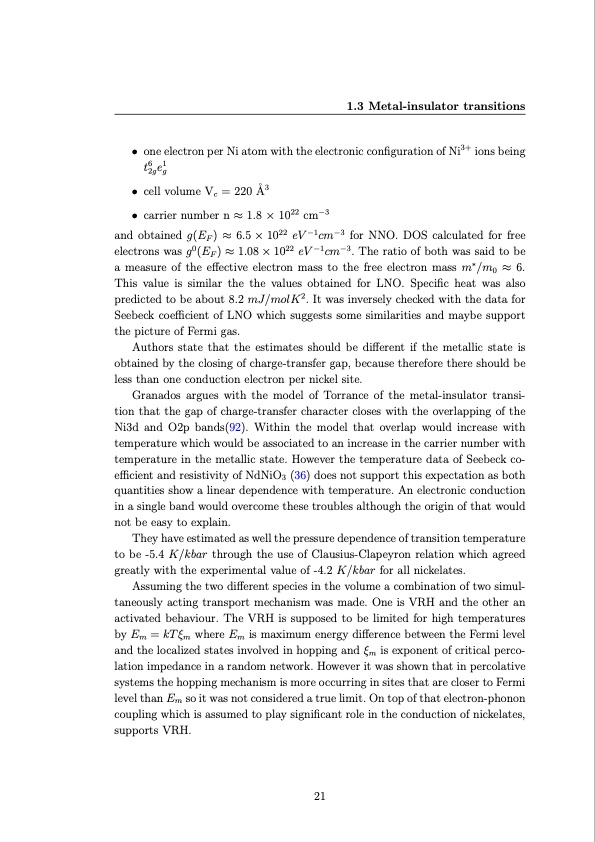
PDF Publication Title:
Text from PDF Page: 042
1.3 Metal-insulator transitions • one electron per Ni atom with the electronic configuration of Ni3+ ions being t62g e1g • cell volume Vc = 220 ̊A3 • carrier number n ≈ 1.8 × 1022 cm−3 and obtained g(EF ) ≈ 6.5 × 1022 eV −1cm−3 for NNO. DOS calculated for free electrons was g0(EF ) ≈ 1.08 × 1022 eV −1cm−3. The ratio of both was said to be a measure of the effective electron mass to the free electron mass m∗/m0 ≈ 6. This value is similar the the values obtained for LNO. Specific heat was also predicted to be about 8.2 mJ/molK2. It was inversely checked with the data for Seebeck coefficient of LNO which suggests some similarities and maybe support the picture of Fermi gas. Authors state that the estimates should be different if the metallic state is obtained by the closing of charge-transfer gap, because therefore there should be less than one conduction electron per nickel site. Granados argues with the model of Torrance of the metal-insulator transi- tion that the gap of charge-transfer character closes with the overlapping of the Ni3d and O2p bands(92). Within the model that overlap would increase with temperature which would be associated to an increase in the carrier number with temperature in the metallic state. However the temperature data of Seebeck co- efficient and resistivity of NdNiO3 (36) does not support this expectation as both quantities show a linear dependence with temperature. An electronic conduction in a single band would overcome these troubles although the origin of that would not be easy to explain. They have estimated as well the pressure dependence of transition temperature to be -5.4 K/kbar through the use of Clausius-Clapeyron relation which agreed greatly with the experimental value of -4.2 K/kbar for all nickelates. Assuming the two different species in the volume a combination of two simul- taneously acting transport mechanism was made. One is VRH and the other an activated behaviour. The VRH is supposed to be limited for high temperatures by Em = kT ξm where Em is maximum energy difference between the Fermi level and the localized states involved in hopping and ξm is exponent of critical perco- lation impedance in a random network. However it was shown that in percolative systems the hopping mechanism is more occurring in sites that are closer to Fermi level than Em so it was not considered a true limit. On top of that electron-phonon coupling which is assumed to play significant role in the conduction of nickelates, supports VRH. 21PDF Image | Investigation of metal-insulator transition in magnetron sputtered samarium nickelate thin films

PDF Search Title:
Investigation of metal-insulator transition in magnetron sputtered samarium nickelate thin filmsOriginal File Name Searched:
Bilewska_Investigation_of_metal_insulator_transition_in_magnetron_sputtered_samarium.pdfDIY PDF Search: Google It | Yahoo | Bing
Sulfur Deposition on Carbon Nanofibers using Supercritical CO2 Sulfur Deposition on Carbon Nanofibers using Supercritical CO2. Gamma sulfur also known as mother of pearl sulfur and nacreous sulfur... More Info
CO2 Organic Rankine Cycle Experimenter Platform The supercritical CO2 phase change system is both a heat pump and organic rankine cycle which can be used for those purposes and as a supercritical extractor for advanced subcritical and supercritical extraction technology. Uses include producing nanoparticles, precious metal CO2 extraction, lithium battery recycling, and other applications... More Info
| CONTACT TEL: 608-238-6001 Email: greg@infinityturbine.com | RSS | AMP |